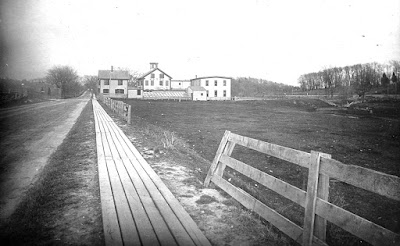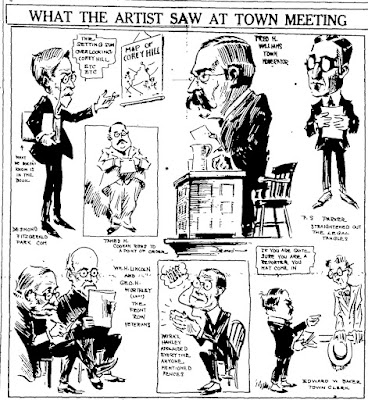 |
| March 22, 1858 |
March 22, 1858 - Vote to lay plank sidewalks on Beacon Street
March 19, 1898 - Lecture on Black university held at Beaconsfield
March 20, 1916 - First Town Meeting under representative format
March 23, 2019 - First recreational marijuana shop in metro Boston opens
March 22, 1858 - Vote to lay plank sidewalks on Beacon Street
The mid-19th century unpaved streets of Brookline were generally adequate for the horse-drawn carriages, carts, and wagons then in use. But dirt and mud were an annoyance, at best, for anyone walking along those streets.
In March 1858, Town Meeting authorized up to $600 to place wooden, or plank, sidewalks along the marshy stretch of Beacon Street west of the Boston line. (Beacon, laid out in 1850-51, was then an unpaved country lane, less than a third of its current width.) More plank sidewalks were added piecemeal in subsequent years as the town grew. Finally, in 1869, Town Meeting authorized the spending of $8,000 for the laying out of
such walks as they shall deem best suited to the different streets, always remembering that a good sidewalk should protect from mud at all seasons of the year.
Beacon Street got special attention, as seen in the 1880s photo above, looking east from Englewood Avenue. Those wooden Beacon Street sidewalks were replaced when the street was widened and paved in the late 1880s, but wooden sidewalks continued to be used in Brookline for many years. The last ones, kept for largely nostalgic reasons, were removed in the 1950s. (See The Long History of Wooden Sidewalks in Brookline for more details and photos.)
 |
| A plank sidewalk on Rawson Road in 1915. (Photo courtesy of National Park Service. Frederick Law Olmsted National Historic Site) |
March 19, 1898 - Lecture on Black university held at Beaconsfield
Atlanta University, founded in 1865 as the first of the Historically Black Colleges & Universities (HBCUs) in the South, was the subject of a talk at the Beaconsfield Casino just outside Washington Square. Speakers included W.E.B. Du Bois, William Lloyd Garrison Jr., and the president of the university, Horace Bumstead.
 |
| Left to right: W.E.B. Du Bois; William Lloyd Garrison Jr., and Horace Bumstead |
Du Bois, a professor at the university (now Clark Atlanta University), spoke [as reported in the Boston Globe] of efforts of the Black population to improve their lives amid "the chaos of public opinion and passions directed against" members of the race. Garrison, son of the famous abolitionist, said that the fight of Southern Blacks for equality was far more important than the war against Spain being fought at the time.
"The struggle in the Southern states among colored men," said Garrison [as reported in the Boston Herald], "against great and unexpected odds, is far greater, their condition being the legacy of slavery, and conditions of 200 years." It was not something, he said, that could be overcome in 35 years.
NOTE: The Beaconsfield Casino, where the Regency Park apartment building is today, was not a casino in the modern sense. It was a social hub for the Beaconsfield Terraces complex of apartments, which still stand. Garrison was a resident of the complex.
March 20, 1916 - First Town Meeting under representative format
Brookline became the first town in Massachusetts to hold a Town Meeting with elected representatives voting on warrant articles instead of the old system where all eligible voters had a say in whether articles were passed.
Brookline became the first town in Massachusetts to hold a Town Meeting with elected representatives voting on warrant articles instead of the old system where all eligible voters had a say in whether articles were passed.
The change had been approved by voters -- men only at that time -- the previous November. The Brookline Chronicle praised the new format as "more like a consultative body bent on working out problems through a free interchange of views than a mass meeting liable to be frightened by its very size into an attitude of hesitancy and reserve."
The town's other paper, the Brookline Townsman, found some humor in the new format, even having a cartoonist illustrate the meeting in its front page. (Click on the image for a larger view.)
 |
| Brookline Townsman cartoon, March 25th, 1916. See full coverage in the Townsman and the Chronicle via the digitized newspapers from the Public Library of Brookline. |
Read much more about the change in government in this 2009 blog post.
March 23, 2019 - First recreational marijuana shop in metro Boston
The NETA dispensary in Brookline Village became the 13th dispensary in Massachusetts -- and the first in metro Boston -- to sell recreational marijuana. Recreational sales had been legalized following a successful 2016 state ballot initiative.
March 23, 2019 - First recreational marijuana shop in metro Boston
The NETA dispensary in Brookline Village became the 13th dispensary in Massachusetts -- and the first in metro Boston -- to sell recreational marijuana. Recreational sales had been legalized following a successful 2016 state ballot initiative.
The NETA store at the corner of Washington and Boylston Streets is located in a former bank building constructed in 1922 for the Brookline Savings Bank (now Brookline Bank). NETA, which had opened the state's first marijuana dispensary in Northampton, had initially taken over the bank space (in 2016) as a dispensary for medical marijuana.
The former bank building, with its dramatic dome, was designed by the Swiss-born architect Franz Joseph Untersee, a longtime resident of Brookline. Untersee also designed the bank's previous building at 366 Washington Street, now the Christian Community church. Other still-standing Untersee-designed buildings in Brookline include the Unified Arts Building at Brookline High School, the school of the St. Mary of the Assumption church, the St. Lawrence church and rectory on Boylston Street, a mixed commercial/residential building at the corner of Cypress and Boylston Streets, and several houses.
 |
| Interior of NETA's Brookline building (Photo courtesty of NETA) |
No comments:
Post a Comment